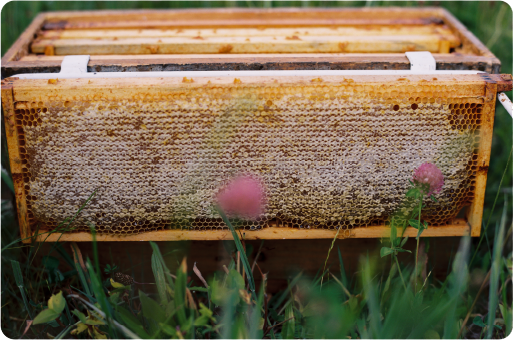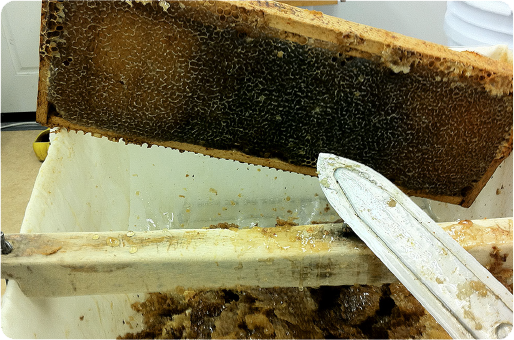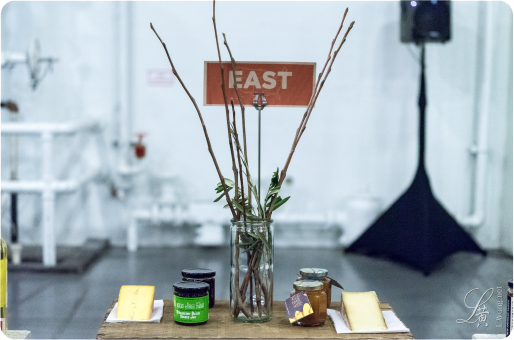Our Honey:
- Raw, unheated and unfiltered.
- Exclusively from OUR bees.
- Seasonally extracted, bottled on demand.
- Three varieties offered.
The flowers, fruits, and trees in our garden know the bees as the pollinators of their splendor. We know honey as the golden confection that results from the bees’ constant industry.
Honey begins as drops of nectar, collected from millions of flowers by tens of thousands of bees. In this gathering, the bees fly hundreds of thousands of miles: back and forth from their hives on journeys that range from feet to miles. (Bees are known to fly as far as five miles for nectar and pollen, but should that be necessary the beekeeper may want to reconsider their location.) Inside the hive, the bees add enzymes of their secreting, and fan their wings to reduce water content. The rich, nutritious honey thus produced is first of all their food. Only the surplus—what remains once the bees have all they need—will carry a Bees’ Needs label.
At Bees’ Needs we practice small-scale beekeeping, using sensitive, non-invasive care that promotes the bees’ survival. We are grateful for the surplus production that allows us to share our raw, unheated and unfiltered honey. Our approach differs both in scale and methods from our commercial counterparts. But we think it is the right choice for all concerned.
With the exception of “Marvelous May” (mostly from black locust trees) single varietal honeys are rare on Long Island. Here there is a rich ecosystem with many kinds of plants in bloom at any moment. Still, those interested in locally produced (not just locally sold honey), benefit from a wide variety of nectars as the seasons change.
 |
Early Harvest: Light in color, fresh and delicate in flavor, this first honey of the year is mostly composed of the nectar of black locust blossoms. We call it “Marvelous May”: although the girls can produce it well into June. |
 |
Middle Harvest: Golden color and bursting with flavor, many sweet nectars of summer go into “Juicy July”: linden, sunflower, lavender and even privet among them. |
 |
Late Harvest: This dark, richly flavorful honey is called “Fabulous Fall”. It contains the first of the goldenrod, Japanese knotweed, perhaps some asters and increasingly buckwheat as more farmers generously plants fields for the bees’ (and the soils’) enjoyment. |

Frame of capped honey K. Wise photo

Uncapping tub and hot knife

Good Food Awards 2016 L. Wong photo
Our Honey: Frequently Asked Questions
Just as we will NEVER sell honey that is not from our bees, we will NEVER heat or highly filter (remove valuable pollen from) our honey.
Our commitment to the bees is to respect and honor their hard work by bringing you a beautiful, unadulterated honey, straight from our hives. We are pleased to say The Good Foods Awards have twice recognized Bees’ Needs with its top prize for flavorful, socially and environmentally responsible food.
A common misconception is that if honey is clear, then it must be pasteurized and that truly raw honey must be crystalized or somehow odd-looking.
It’s true that many commercial honey packers heat honey to retard crystallization and prolong its shelf life. (This is ironical, since honey is the only natural food that never spoils). However, we bottle our honey by hand and on demand, while it is still liquid: this is why it is always clear, at first. It will, eventually crystalize, sometimes within days, sometimes much longer (if it isn’t consumed first!).
Crystallization is a natural process; honey is a super-saturated sugar solution that ‘wants’ to be solid. It is interesting to know that honeys crystalize at different rates, depending on the glucose/fructose rations of their nectars. So, for example, tupelo and black locust crystalize slowly, goldenrod and alfalfa quickly.
An effective way to combat allergies is to consume raw and unfiltered honey, produced from the allergy-triggering plant, honey which will contain small amounts of pollen that homeopathically ‘treat’ the allergy.
Our seasonally bottled and sold honeys increase the likelihood that seasonal choices allow allergy sufferers to target specific pollen triggers by the months in which they appear. Keep in mind, many allergies triggered by wind-pollinated plants are not foraged on by bees.
It is important to note that honey does not only actively combat specific allergies, it enhances the immune system as a whole.
“Perhaps the most astounding statement one can make about honey is that it accomplishes something for almost every organ, tissue, cell, or system in the body without one complication, risk or negative consequence.”
Dr. Ron Fessenden from The New Honey Revolution: Restoring the Health of Future Generations
Dr. Fessenden’s book is truly revolutionary in its exhaustive exploration of the health benefits of honey. He outlines five mechanisms of action, with numerous examples contained within each, which are as follows:
- the metabolic benefits such as stabilization of blood sugar and reduction of insulin response,
- the improvement of sleep by feeding the brain, thereby reducing metabolic stress,
- the enhancement of the immune system through its antioxidant and anti-inflammatory properties,
- the antimicrobial benefits, specifically for use in treatment of skin infections, skin ulcers and treatment of burns,
- a general category of miscellaneous benefits, including refueling before, during and after exercise.
We cannot recommend this remarkable book highly enough!
Though our beekeeping methods are founded in biodynamics, it would be impossible to call our honey organic. We take great care to locate our hives out of harm’s way, for example, by finding homes with like-minded farmers. This is not enough to protect them in all situations. Bees commonly forage in a two mile radius, an area of 8,000 acres, and in rare situations upwards of five miles. While we much prefer that such acreage be managed without chemicals, it’s not achievable given our area’s numerous land uses and ownership. This underscores the importance for all, each homeowner, gardener and outdoor enthusiast alike. We encourage good management choices, for the sake all living things.



